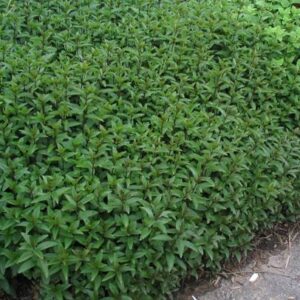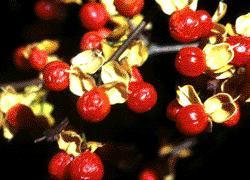
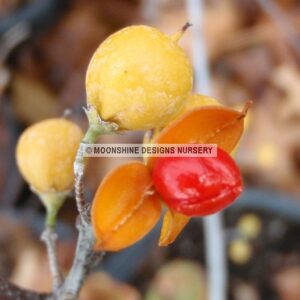
American Bittersweet, Sexed Plants
American bittersweet is a native woody and shrubby climber, growing over trees or fences. It has smooth thin leaves 2 to 4 inches long and about half as wide. The small greenish-white flowers are produced in June in short clusters. The fruit is a round, orange-yellow capsule which opens in autumn, disclosing the scarlet-colored seed pod. The seed capsules remain on the plant well into the cold season and provide food for birds in the winter. Fruits are eaten by songbirds, ruffed grouse, pheasants, bobwhite and squirrel. Old fruits are eaten as survival foods by many birds and animals in late winter. Fruits should NOT be eaten by humans. While not extremely toxic, they will “clean you out at both ends”. Bunches of twisted branchlets, loaded with fruit, are very decorative and the plant is disappearing in many places because of the ruthless methods of market pickers. Our stock is not from the wild!! We have selected ‘stock’ plants which grow on site here and have chosen the best over the years for the most desirable characteristics.
Way back in the dark and mysterious past, many shepherds hung bittersweet around the necks of those sheep which were suspected to be under the evil eye. I don’t think it is really necessary myself. Save this bit of lore for your next trivia game.
Often planted as an ornamental vine for the showy fruits. A good climber on trellises, arbors, porches. Fast growing. Decorative berries and twisted vines make interesting projects.
You will need both male and female plants to produce berries! 1 male can pollinate 4-5 female vines. MUST be planted within 30 feet of each other.
Light: Partial to full sun. Best fruit in full sun.


American Bittersweet, unsexed
American bittersweet is a native woody and shrubby climber, growing over trees or fences. It has smooth thin leaves 2 to 4 inches long and about half as wide. The small greenish-white flowers are produced in June in short clusters. The fruit is a round, orange-yellow capsule which opens in autumn, disclosing the scarlet-colored seed pod. The seed capsules remain on the plant well into the cold season and provide food for birds in the winter. Fruits are eaten by songbirds, ruffed grouse, pheasants, bobwhite and squirrel. Old fruits are eaten as survival foods by many birds and animals in late winter. Fruits should NOT be eaten by humans. While not extremely toxic, they will “clean you out at both ends”. Bunches of twisted branchlets, loaded with fruit, are very decorative and the plant is disappearing in many places because of the ruthless methods of market pickers. Our stock is not from the wild!! We have selected ‘stock’ plants which grow on site here and have chosen the best over the years for the most desirable characteristics.
Way back in the dark and mysterious past, many shepherds hung bittersweet around the necks of those sheep which were suspected to be under the evil eye. I don’t think it is really necessary myself. Save this bit of lore for your next trivia game.
Often planted as an ornamental vine for the showy fruits. A good climber on trellises, arbors, porches. Fast growing. Decorative berries and twisted vines make interesting projects.
You will need both male and female plants to produce berries! 1 male can pollinate 4-5 female vines. MUST be planted within 30 feet of each other.
Light: Partial to full sun. Best fruit in full sun.


American Bittersweet, unsexed Wholesale
American bittersweet is a native woody and shrubby climber, growing over trees or fences. It has smooth thin leaves 2 to 4 inches long and about half as wide. The small greenish-white flowers are produced in June in short clusters. The fruit is a round, orange-yellow capsule which opens in autumn, disclosing the scarlet-colored seed pod. The seed capsules remain on the plant well into the cold season and provide food for birds in the winter. Fruits are eaten by songbirds, ruffed grouse, pheasants, bobwhite and squirrel. Old fruits are eaten as survival foods by many birds and animals in late winter. Fruits should NOT be eaten by humans. While not extremely toxic, they will “clean you out at both ends”. Bunches of twisted branchlets, loaded with fruit, are very decorative and the plant is disappearing in many places because of the ruthless methods of market pickers. Our stock is not from the wild!! We have selected ‘stock’ plants which grow on site here and have chosen the best over the years for the most desirable characteristics.
Way back in the dark and mysterious past, many shepherds hung bittersweet around the necks of those sheep which were suspected to be under the evil eye. I don’t think it is really necessary myself. Save this bit of lore for your next trivia game.
Often planted as an ornamental vine for the showy fruits. A good climber on trellises, arbors, porches. Fast growing. Decorative berries and twisted vines make interesting projects.
You will need both male and female plants to produce berries! 1 male can pollinate 4-5 female vines. MUST be planted within 30 feet of each other.
Light: Partial to full sun. Best fruit in full sun.
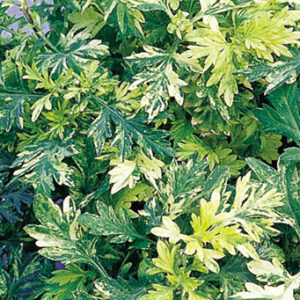
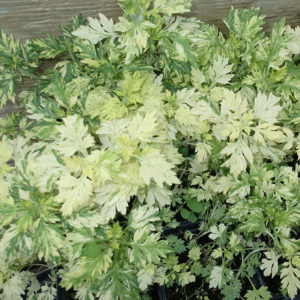
Artemisia, Oriental Limelight Plug Flat
A tall grower that¹s great in beds, borders, and large containers. The mounding, self-branching habit makes Oriental Limelight an ideal companion for many flowering plants. Variegated lemon yellow and green foliage.
Zone 3-11
Full sun
18-36″ tall and wide
Best grown in a container or a confined space as this tends to spread rapidly.
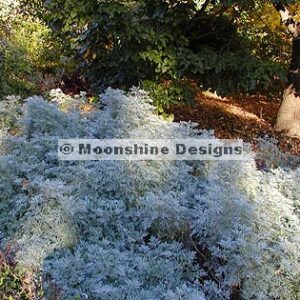
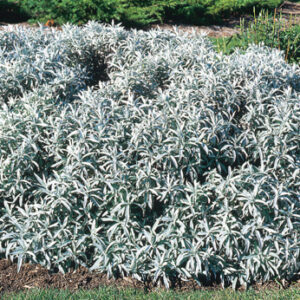
Artemisia, Silver Mound Plug Flat
A low grower that¹s great in beds, borders, and containers. The mounding, self-branching habit makes this fine-cut silver foliage perennial an ideal companion for many flowering plants.
Zone 3-11
Full sun
10-15″ tall and wide
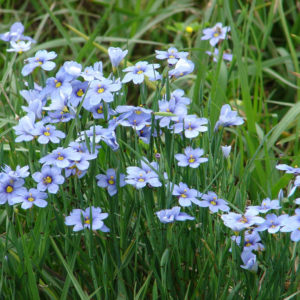
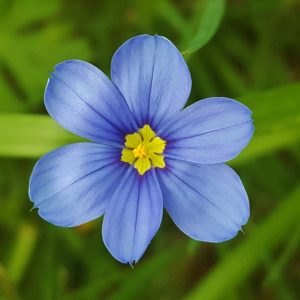
Blue Eyed Grass (Sisyrinchium bellum) Plug Flat
Blue-eyed Grass (Sisyrinchium bellum)
• Season: Perennial
• USDA Zones: 4 – 9
• Height: 6 – 12 inches
• Bloom Season: Spring
• Bloom Color: Blue-Purple
• Environment: Partial to Full sun
• Soil Type: Moist, well-drained, pH 6.1 – 7.5
50 count Plug Flat
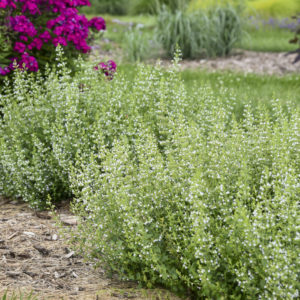
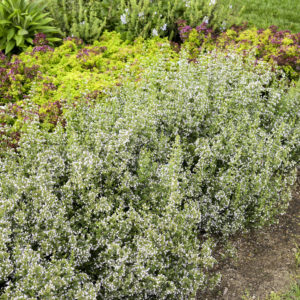
Calamintha Nepeta (Calamint) 70 ct. Plug Flat
Calamintha nepeta ssp. nepeta Common Name: Calamint, Lesser Catmint
2021 Perennial Plant Association Plant of the Year™
This sun-loving perennial is the perfect choice for attracting pollinators, since it blooms from early summer until frost. Tiny, white to light blue flowers cover the bushy habit. Since this is in the mint family, the leaves carry a mint scent. Perfect for rock garden enthusiasts and herb gardens. Use in the landscape as you would Nepeta (Catmint).
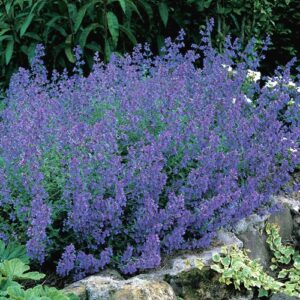

Catmint, Blue Carpet Plug Flat
Profuse blue blooms on spiky stems.
Soft, crinkled, gray-green leaves on a short, mounding plant.
Good in containers, for borders, and the perennial herb garden. Very good choice for a tough, perennial ground cover!
Contains nepetalactone, the active ingredient in catnip that drives cats nuts..
Medicinal: In tea for nervous tension, sleeplessness. Catmint tea will put you to sleep in short order. Do not take this if operating a car or machinery!
Sun to Part Shade. 8-10″.
Zones 4-8. Hardy perennial herb.
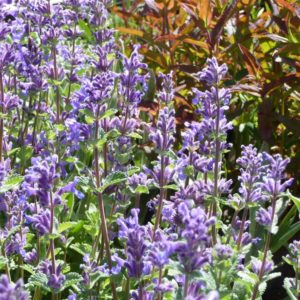
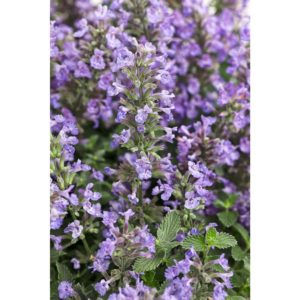
Catmint, Border Ballet Plug Flat
Nepeta (Catmint) grandiflora Border Ballet
Height: 16 inches
Zone: 4
Caucausus Catmint, lush violet purple flowers, dark green leaf, great shape with no staking, wonderful scent
A striking Catmint with flower stalks of Blue and Whitish Pink flowers that attract the bees and butterflies to dance in the garden. It’s a perennial that flowers in the first year and has a long growing season. Aromatic lush foliage, requiring very little maintenance.
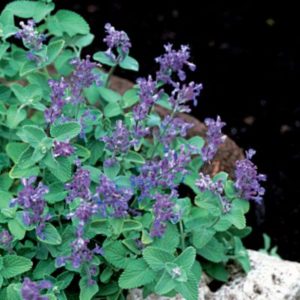

Catmint, Felix Plug Flat
Profuse blue blooms on spiky stems.
Soft, crinkled, gray-green leaves on a short, mounding plant.
Good in containers, for borders, and the perennial herb garden. Very good choice for a tough, perennial ground cover!
Contains nepetalactone, the active ingredient in catnip that drives cats nuts..
Medicinal: In tea for nervous tension, sleeplessness. Catmint tea will put you to sleep in short order. Do not take this if operating a car or machinery!
Sun to Part Shade. 8-10″.
Zones 4-8. Hardy perennial herb.
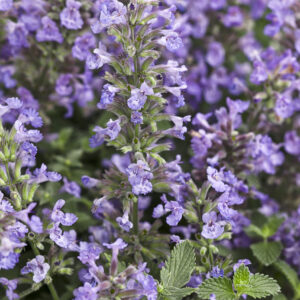
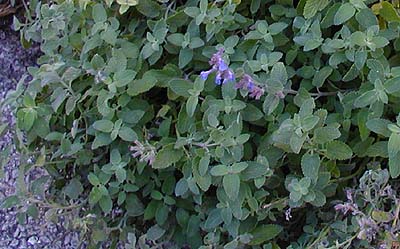
Catmint, Little Titch Plug Flat
Deep lavender-blue flowers and it is one of the most vividly colored catmints. Blooms from June to September.
Soft, crinkled, gray-green leaves on a short, mounding plant.
Good in containers, for borders, and the perennial herb garden. Very good choice for a tough, perennial ground cover!
Contains nepetalactone, the active ingredient in catnip that drives cats nuts..
Medicinal: In tea for nervous tension, sleeplessness. Catmint tea will put you to sleep in short order. Do not take this if operating a car or machinery!
Sun to Part Shade. 10-14″ height and 12-14″ spread.
Zones 4-8. Hardy perennial herb.
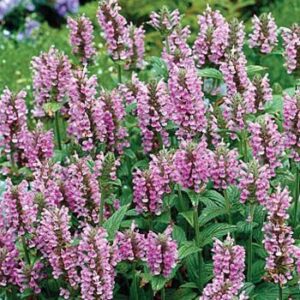

Catmint, Pink Cat Plug Flat
Pink Cat is an early blooming and mounding variety of Catmint that is not commonly found. This type is somewhat shorter and bushier that common Catmint. It forms fragrant pink spikes that will attract hummingbirds, butterflies and bees.
Pink Cat works well in containers as well as in your perennial border. Compact, heat tolerant, and easy to grow with aromatic leaves.
Use as a great general ground cover, accent plant, pathway edger, or rock garden specimen. (not for foot traffic)
Catmint needs good drainage and kept too wet, will develop crown rot. Shearing Catmint plant after blooming will encourage more branching and repeated flushes of flowers.
Zones 4-8. Hardy perennial herb.


Catmint, Walker’s Low Plug Flat
TOP SELLER! Deep lavender-blue flowers and it is one of the most vividly colored catmints. Blooms from June to September.
Soft, crinkled, gray-green leaves on a short, mounding plant.
Good in containers, for borders, and the perennial herb garden. Very good choice for a tough, perennial ground cover!
Contains nepetalactone, the active ingredient in catnip that drives cats nuts..
Medicinal: In tea for nervous tension, sleeplessness. Catmint tea will put you to sleep in short order. Do not take this if operating a car or machinery!
Sun to Part Shade. 10″ height and 12-14″ spread. Zones 4-8. Hardy perennial herb.


Chives, Garlic or Onion, Plug Flat
The subtle and pleasant taste of chives make them an extremely popular food addition! Fresh chives, finely chopped, are sprinkled over soups, baked potatoes, stews, and several sauces. In mid-Summer, they will also put on quite a show with their abundant, fragrant flowers. Certainly just as well at home in the flower garden as the herb garden. Perfect year around windowsill plant, too!
In Chinese cooking, the flat leaves of garlic chives are often used the same way as we use regular chives in our cooking:., sprinkled over foods for extra fragrance and decoration. Garlic chives can be substituted by regular chives, but since regular chives have a weaker flavor, it is worthwhile to grow both so you will always have an ample supply of either one for what ever the recipe calls for.
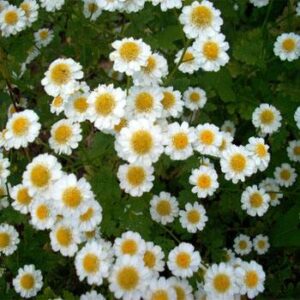

Feverfew Plug Flat
Feverfew has many uses, including preventing migraine headaches in some people.
Feverfew is also said to be effective for fever, irregular menstrual periods, arthritis, a skin disorder called psoriasis, allergies, asthma, ringing in the ears (tinnitus), dizziness, and nausea and vomiting.
Some people use feverfew for difficulty getting pregnant or fathering a child (infertility). It is also used for “tired blood” (anemia), cancer, common cold, earache, liver disease, prevention of miscarriage, muscular tension, bone disorders, swollen feet, diarrhea, upset stomach and intestinal gas. Feverfew is sometimes applied directly to the gums for toothaches or to the skin to kill germs.
Feverfew is a medicinal herb with a long history of use. The leaves are dried and used as an herbal remedy for migraine headaches. The Feverfew herb contains parthenolide which can relieve mild spasms and is an anti-inflammatory. Some people take it to relieve the pain of rheumatoid arthritis.
We make no claims as to the effectiveness of any herbal treatment and the above text is for information only.
As an ornamental, it is a hardy perennial with deeply cut leaves and lovely daisy-like blooms that measure 3/4 inch across. It is native to Southern Europe, but can be found in many areas of the world. A synonymous botanical name is Tanacetum Parthenium.
Hardy Zones 5-8
Will tolerate even the poorest soils provided it is not soggy.
Best in full sun.
Height: 36″. Space plants 24″.
Bloom time: early to mid-late summer. Blooms can easily be cut and dried.
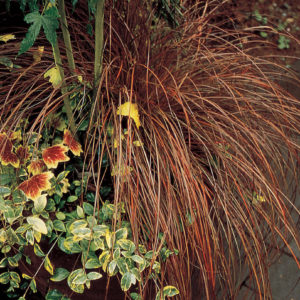

Grass, Toffee Twist (Carex)
From the John Greenlee™ Grass Collection.
Mounded. Iridescent slender leaves drape gracefully over color bowls, Especially attractive as an accent plant. Easy to grow.
Full Sun to Partial Shade Height: 10-16” Spacing: 16-24″ Zone: 7-11 (We have had this survive our zone 5a with a heavy mulch of leaves after the first hard frost, but must be in the ground, not a container)
Grown and Shipped in quart perennial pots in active growth 6-10″ + in height.
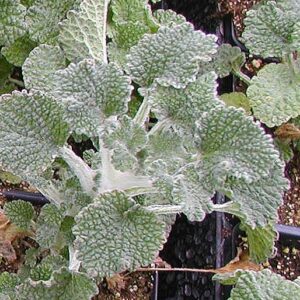
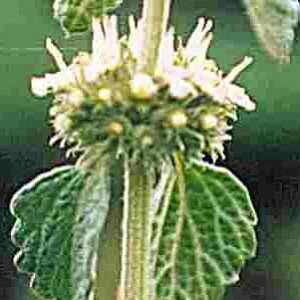
Horehound Plug Flat
The key ingredient for making old-fashioned Horehound candy.
This tough Perennial herb has attractive, fuzzy gray foliage. Zones 4-9
Most used for flavoring honey and candy.
Has a rich history in medicine. Horehound candy is also used to treat coughs, sore throat.
Will tolerate even the poorest soils provided it is not soggy.
Best in full sun.
Height: 36″. Space plants 24″.
Bloom time: early to mid-late summer.

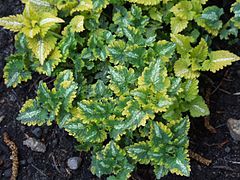
Lamium, Anne Greenaway Plug Flat
Common name is Spotted Dead Nettle
Deer-resistant Self-cleaning, no deadheading necessary.
An exquisite blend of chartreuse, silver, medium-green, and mint green embellishes the foliage of L. ‘Anne Greenaway’. With such fantastic coloring, this groundcover is breathtaking even when not in bloom. Mauve flowers add to the ornamental value from late spring into early summer, then bloom sporadically until frost. Evergreen in zones 7 and above.
Exposure: Plant in sun or shade Height 8-12″ Spacing 10-14″ Hardy Temp: -30°F (-34°C) Zones 4-9 Perennial Uses: Plant alone or in combinations in all container types and landscapes. Excellent groundcover.
Lamium, Beacon Silver Plug Flat
Common name is Spotted Dead Nettle
Deer-resistant Self-cleaning, no deadheading necessary.
This popular variety has silvery leaves with narrow, green margins which provide a lovely backdrop for the lavender-to-pink, hooded flowers produced from midspring to early summer. Lamium makes an excellent, weed-smothering groundcover and is also a good mask for dying bulb foliage.
Evergreen in zones 7 and above.
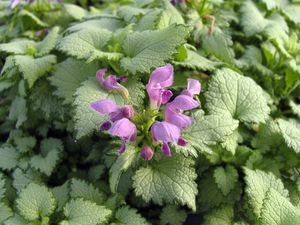
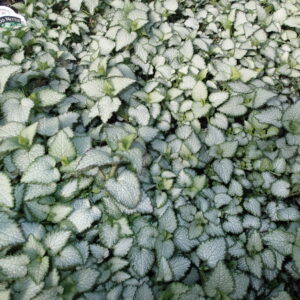
Lamium, Ghost Plug Flat
Common name is Spotted Dead Nettle
Deer-resistant Self-cleaning, no deadheading necessary.
This very large variety dwarfs other lamiums by comparison! Standing about a foot tall, the all-silver leaves create a billowy cloud of silver in the garden. The leaves measure a full 1.5 inches long compared to 1/2 to 3/4 inches long on other varieties.
Clusters of large, bright orchid purple flowers top the clump of silver foliage in mid to late spring. The contrast between the flowers and foliage is striking and often stops passersby in their tracks! Blooms from late April thru August.
Lamium makes an excellent, weed-smothering groundcover and is also a good mask for dying bulb foliage.
Evergreen in zones 7 and above.
Exposure: Plant in sun or shade
Height 10-16″ Spacing 10-14″
Hardy Temp: -30°F (-34°C) Zones 4-9 Perennial
Uses: Plant alone or in combinations in all container types and landscapes. Excellent groundcover.
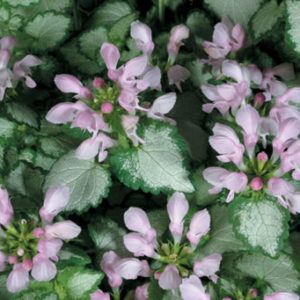

Lamium, Pink Chabils-Proven Winners
Common name is Dead Nettle
Deer-resistant Self-cleaning, no deadheading necessary.
Exposure
Plant in sun or shade
Height 8-12″ Spacing 10-14″
Hardy Temp
-30°F (-34°C) Zones 4-9 Perennial
Uses
Plant alone or in combinations in all container types and landscapes
Features
A frothy confection of silver and green foliage with cotton candy pink flowers; heat tolerant
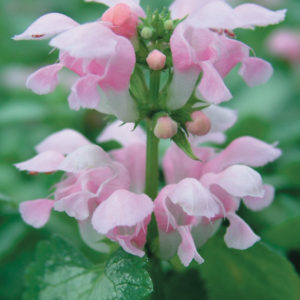

Lamium, Pink Pewter Plug Flat
Common name is Spotted Dead Nettle
Deer-resistant Self-cleaning, no deadheading necessary.
Exposure: Plant in sun or shade
Height 8-12″ Spacing 10-14″
Hardy Temp: -30°F (-34°C) Zones 4-9 Perennial
Uses: Plant alone or in combinations in all container types and landscapes
Features: A frothy confection of silver and green foliage with pink flowers; heat tolerant
Lamium makes an excellent, weed-smothering groundcover and is also a good mask for dying bulb foliage.
Evergreen in zones 7 and above. Excellent groundcover.
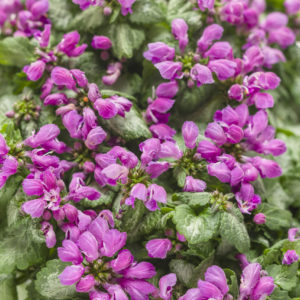

Lamium, Purple Chabils-Proven Winners
Common name is Dead Nettle
Deer-resistant Self-cleaning, no deadheading necessary.
Exposure
Plant in sun or shade
Height 8-12″ Spacing 10-14″
Hardy Temp
-30°F (-34°C) Zones 4-9 Perennial
Uses
Plant alone or in combinations in all container types and landscapes
Features
A frothy confection of silver and green foliage with lavender-purple flowers; heat tolerant
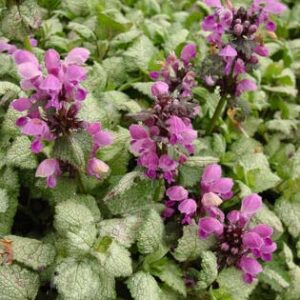
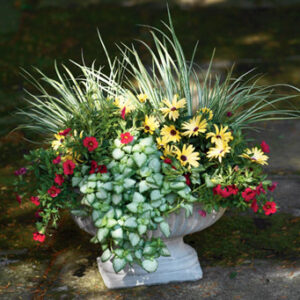
Lamium, Red Nancy Plug Flat
Common name is Spotted Dead Nettle
Deer-resistant Self-cleaning, no deadheading necessary.
Exposure: Plant in sun or shade
Height 8-12″ Spacing 10-14″
Hardy Temp: -30°F (-34°C) Zones 4-9 Perennial
Uses: Plant alone or in combinations in all container types and landscapes
Features: A frothy confection of silver and green foliage with purple-red flowers; heat tolerant (Our note: Blooms are more of a violet color than red)
Lamium makes an excellent, weed-smothering groundcover and is also a good mask for dying bulb foliage.
Evergreen in zones 7 and above. Excellent groundcover.
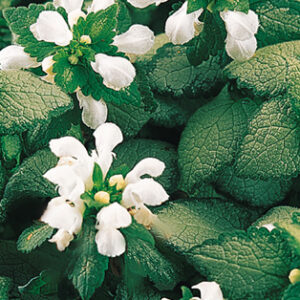

Lamium, White Nancy Plug Flat
Common name is Spotted Dead Nettle
Deer-resistant Self-cleaning, no deadheading necessary.
Exposure: Plant in sun or shade
Height 8-12″ Spacing 10-14″
Hardy Temp: -30°F (-34°C) Zones 4-9 Perennial
Uses: Plant alone or in combinations in all container types and landscapes
Features: A frothy confection of silver and green foliage with white flowers; heat tolerant
Lamium makes an excellent, weed-smothering groundcover and is also a good mask for dying bulb foliage.
Evergreen in zones 7 and above. Excellent groundcover.


Lavender, Hidcote Superior Plug Flat
The classic form complete with wonderful fragrance! A necessity in the garden or landscape! This is the true lavender! Just brushing up against it will release its intense aroma! The foliage is silver-gray, and the flowers are deep violet-blue-colored. The leaves are evergreen and reach 2 in. long. Flowering occurs in summer, and the flowers are ¼–½ in. long, form interrupted spikes, and have an attractive fragrance. The leaves and the flowers are aromatic and have many uses.
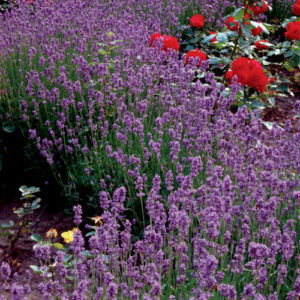

Lavender, Lavender Lady Plug Flat
This AAS winner offers blue-green foliage on very uniform plants just 10 to 16 inches high! Lavender angustifolia is one of the richest in essential oils, meaning more fragrance power both fresh and dried. And this ‘Lady’ cultivar, an AAS winner, has a more uniform habit and it blooms in only 90 days from seed! Fresh flowers can be crystallized and used in candies and cakes; dried flowers are used in potpourris and sachets; oils are used in creams and perfumes. And these are only some of the more common uses – imagination can create endless more! An evergreen perennial, Lavender ‘Lady’ has a subtle blue-green coloring and sweet fragrance. Reaching 10 to 16 inches high and 10 inches wide, it boasts 2 1/2 inch, linear, downy leaves on strong stems. The leaves first open white, then turn a pale gray-blue-green color. Stalks of lavender flowers grow up to 12 inches tall above the foliage.
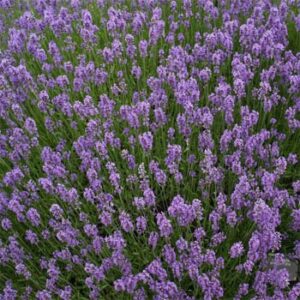

Lavender, Munstead Plug Flat
The classic form complete with wonderful fragrance! A necessity in the garden or landscape! This is the true lavender! Just brushing up against it will release its intense aroma! The foliage is silver-gray, and the flowers are deep violet-blue-colored. The leaves are evergreen and reach 2 in. long. Flowering occurs in summer, and the flowers are ¼–½ in. long, form interrupted spikes, and have an attractive fragrance. The leaves and the flowers are aromatic and have many uses. Compact grower makes it ideal for lining walkways, the back of the herb garden, or for growing among roses and taller companion plants. Deer don’t like it Zones 5-9 20-30″ High x 18″ Wide Optimal growing conditions: True lavender is soil and drought tolerant but performs best in well-drained soil under full sun. Drainage is the most important factor. Another thing useful to know: Growth can be slow and soft in heavy soils, and a hardiness problem may appear. In good conditions, the growth rate is moderate.
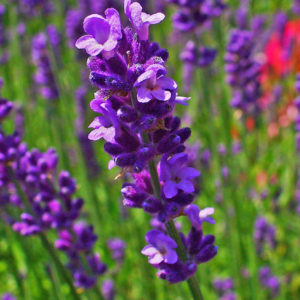

Lavender, Vera Plug Flat
Lavandula angustifolia ‘vera’ Most common commercial grown variety This is the true lavender! Just brushing up against it will release its intense aroma! The foliage is silver-gray, and the flowers are deep violet-blue-colored. The leaves are evergreen and reach 2 in. long. Flowering occurs in summer, and the flowers are ¼–½ in. long, form interrupted spikes, and have an attractive fragrance. The leaves and the flowers are aromatic and have many uses. Compact grower makes it ideal for lining walkways, the back of the herb garden, or for growing among roses and taller companion plants. Deer don’t like it Zones 5-9 20-30″ High x 18″ Wide Optimal growing conditions: True lavender is soil and drought tolerant but performs best in well-drained soil under full sun. Drainage is the most important factor. Another thing useful to know: Growth can be slow and soft in heavy soils, and a hardiness problem may appear. In good conditions, the growth rate is moderate.
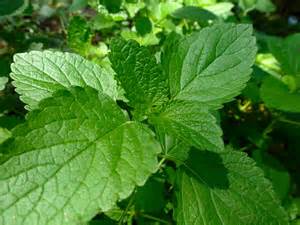
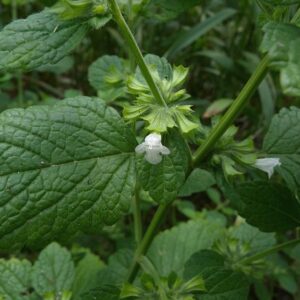
Lemon Balm Plug Flat
The key ingredient for making lemon balm tea.
This tough Perennial herb has a great lemon scent. Zones 4-9
Will tolerate even the poorest soils provided it is not soggy.
Best in full sun.
Height: 24″. Space plants 24″.
Bloom time: early to mid-late summer.
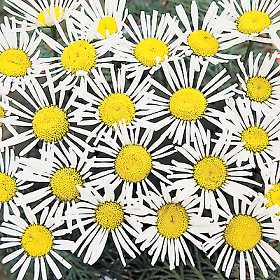
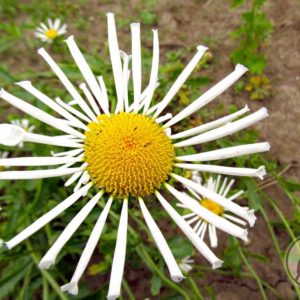
Leucanthemum (Shasta Daisy) Silver Spoons Plug Flat
Leucanthemum (Shasta Daisy) superbum Silver Spoons
Height: 36 inches
Zone: 3
Tall erect stems, unique spoonlike pure white petals, yellow center, mounded habit
(Formerly Chrysanthemum maximum) No sunny border would seem complete without the familiar presence of Shasta Daisies. This is a terrific dwarf strain, producing a low mound with a long succession of large white yellow-eyed daisies. Great for edging, also excellent in tubs or mixed containers. Divide plants in the spring every 2 to 3 years to maintain vigor. Removing faded flowers regularly will greatly increase the blooming time. Attractive to butterflies.
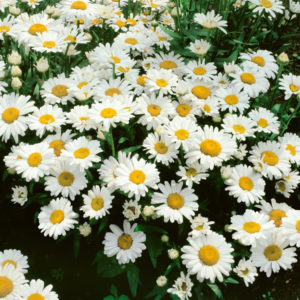
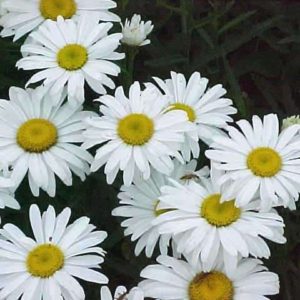
Leucanthemum (Shasta Daisy) Snow Lady Plug Flat
Leucanthemum (Shasta Daisy) Snow Lady
Height: 8 inches
Zone: 3
AAS Winning F1 hybrid: Compact, floriferous, weather tolerant, great garden performance.
(Formerly Chrysanthemum maximum) No sunny border would seem complete without the familiar presence of Shasta Daisies. This is a terrific dwarf strain, producing a low mound with a long succession of large white yellow-eyed daisies. Great for edging, also excellent in tubs or mixed containers. Divide plants in the spring every 2 to 3 years to maintain vigor. Removing faded flowers regularly will greatly increase the blooming time. Attractive to butterflies.

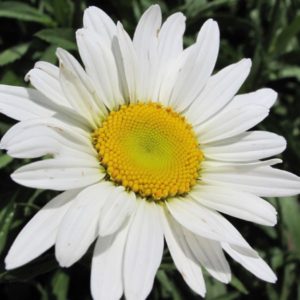
Leucanthemum (Shasta Daisy) White Breeze Plug Flat
Leucanthemum (Shasta Daisy) leucanthemum White Breeze
Height: 11 inches
Zone: 3
Fleuroselect, Ultra compact, pure white shasta daisies with prominent yellow eye, sturdy upright habit, flowers first year
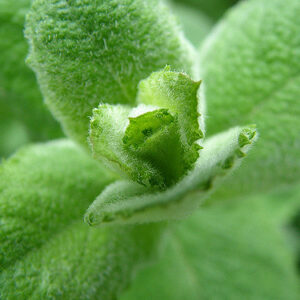

Mint, Apple Plug Flat
This hardy perennial is a very robust grower. Apple Mint has interesting light green leaves. They are somewhat hairy on the upper surface and downy underneath, with serrated edges. They can grow up to 3 feet high, but may be kept lower.
Grow Apple Mint in full sun to light shade. Feed them heavily in late summer to guarantee healthy growth the following spring. Apple Mint will survive in dry soil, but will do much better in moist, fertile ground. Cut back or mow down the Mint patch 2 or 3 times a year to encourage fresh growth. Cut the stems even with the ground and throw out the long, woody stems. Strip off and dry whole leaves for potpourris. Save the top 2 to 3 sets of leaves for fresh use and garnishes. Apple Mint’s fragrance may vary in strength; the mild apple flavor doesn’t sustain well in dried leaves.
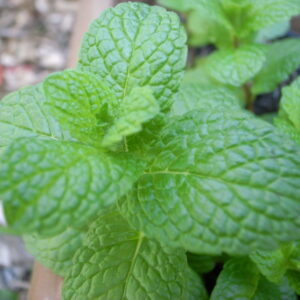
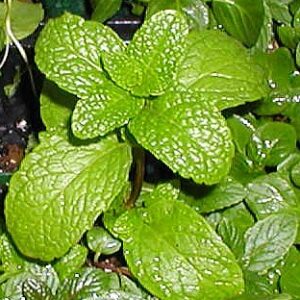
Mint, Spearmint, Kentucky Colonel Plug Flat
THE MOJITO MINT! Commercially grown for Mint Juleps, Mojitos, and spearmint flavoring. Large, dark green, slightly crinkly leaves. Kentucky Colonel is a reliably hardy, strongly flavored spearmint that is favored by many herb growers. OUR MOST POPULAR MINT!

